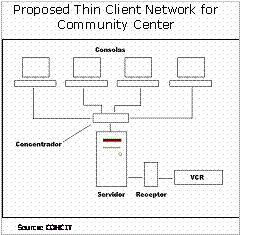Honduras - Off-grid Telecenters
Home > RESOURCES > Case Studies > Latin America & Caribbean > Honduras - Off-grid Telecenters
In 2003, the Honduran Council for Science and Technology (COHCIT) began implementing the pilot phase of a plan to establish 100 rural community centers around the country. The community centers were to provide a variety of ICT services, and would be equipped with computers, printers, photocopiers, television/VHS equipment, and presentation projectors. Between 10 and 15 of the centers would not have access to the electricity grid. Having tried installing full-power desktop systems in a PV-powered telecenter in a previous project called Aldeas Solares, COHCIT realized that the new off-grid centers would need to be powered by renewable energy systems and would thus require a modified approach to equipment selection. With support from the World Bank, SWTDI-New Mexico State University (NMSU), Sandia National Laboratory and the International Telecommunication Union (ITU), COHCIT considered options for reducing total investment costs in the off-grid telecenters by selecting energy efficient ICT equipment. Compared to centers with grid electricity, the off-grid centers would be reduced in size: four to seven personal computers, a TV, a VCR, and an ink jet printer instead of a laser jet printer. To reduce the power requirements even further, the project considered the installation of thin client terminals connected to a single on-site server in off-grid centers (see diagram at right). With a VCR connected to the server, the thin client LCD displays could be used for watching recorded programs, thus eliminating the need for a conventional television set.
Despite the energy cost savings associated with the thin client network, it was not implemented on the grounds that the risk to business operations was too great if the center's computer services relied on a single server. |

 COHCIT issued a request for PV system quotations in which the thin client network was proposed for a community center in Las Tejas, while a network of standard desktop systems was proposed for a second off-grid center in Montana Grande. The standard desktop configuration led to a quotation of $23,500 for a 1,200 Wp system, whereas the thin client configuration resulted in a quotation of $12,250 for a 700 Wp system, a cost reduction of nearly 48%.
COHCIT issued a request for PV system quotations in which the thin client network was proposed for a community center in Las Tejas, while a network of standard desktop systems was proposed for a second off-grid center in Montana Grande. The standard desktop configuration led to a quotation of $23,500 for a 1,200 Wp system, whereas the thin client configuration resulted in a quotation of $12,250 for a 700 Wp system, a cost reduction of nearly 48%.